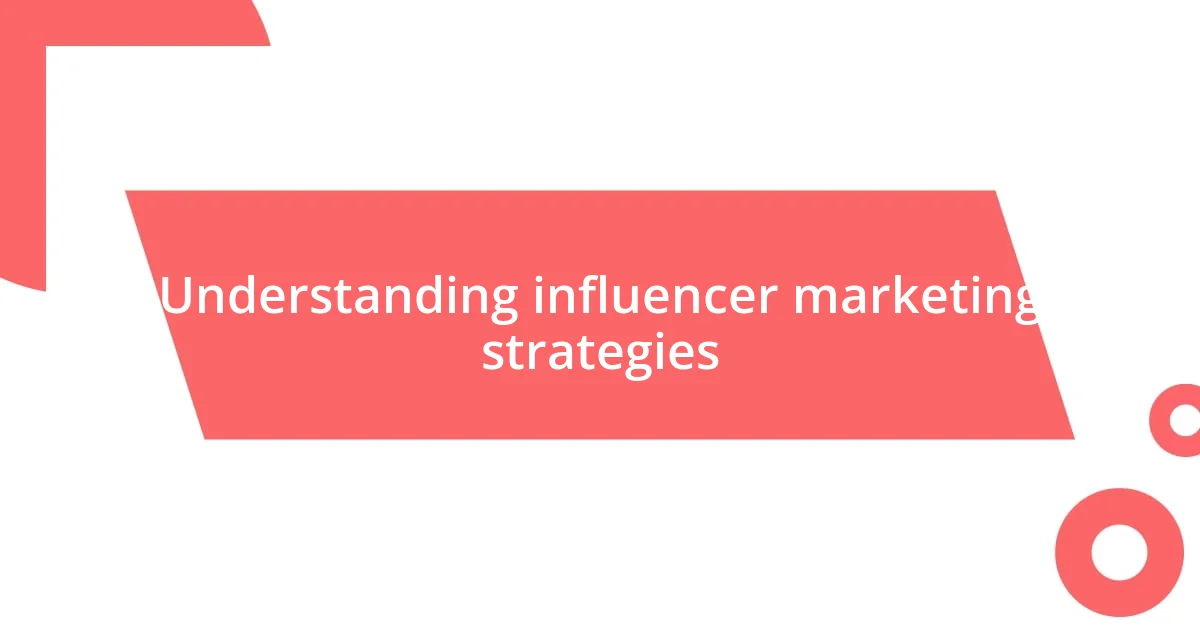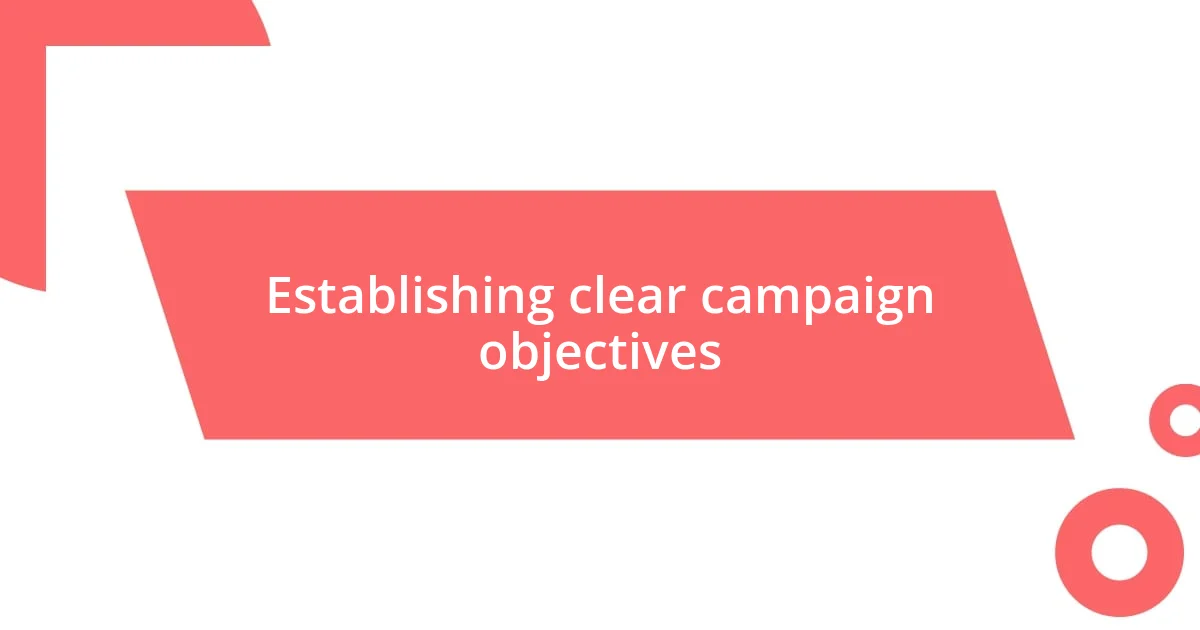Key takeaways:
- Choose the right influencers based on audience demographics, engagement rate, and content relevance to ensure authenticity and impactful engagement.
- Establish SMART objectives for campaigns to maintain direction and achieve measurable results that align with broader marketing goals.
- Foster long-term relationships with influencers through ongoing communication and collaboration, optimizing future partnerships for deeper audience connections.

Understanding influencer marketing strategies
Influencer marketing strategies are all about connecting brands with the right voices that resonate with their target audience. I remember the first time I partnered with a micro-influencer; their authenticity shone through, and it felt like a genuine conversation rather than a sales pitch. Have you ever noticed how some brands seem to fit perfectly into the content you love? That’s the magic of choosing influencers whose values align with yours.
Understanding these strategies also means recognizing the dynamics of different platforms. For instance, I found that Instagram’s visual storytelling worked wonders for a beauty campaign I once ran, while a podcast collaboration opened doors to a more engaged audience. Why do some campaigns thrive while others fizzle out? Often, it’s about knowing where your audience spends their time and what type of content they crave.
It’s crucial to measure the impact of these strategies as well. I’ve learned that digging into metrics, like engagement rates and conversion statistics, provides invaluable insights. Have you ever been surprised by which posts sparked the most interest? Analyzing these outcomes helps refine future campaigns, ensuring each one is more effective than the last. Each decision taken during this process shapes not just the campaign, but also the brand’s long-term relationship with its audience.

Identifying the right influencers
Finding the right influencers can feel like a treasure hunt, but I’ve learned that investing time in this stage pays off significantly. One of my best campaigns came together when I discovered an influencer who not only had a loyal following but also genuinely used the product I was promoting. Trust me, when audiences see that authenticity, it resonates deeply and leads to more impactful engagement.
To effectively identify the right influencers, consider these key points:
- Audience Demographics: Are their followers aligned with your target market?
- Engagement Rate: Look for influencers who actively engage with their audience—higher interaction can signal a devoted community.
- Content Relevance: Does their content style and messaging align with your brand values?
- Past Campaign Success: Have they successfully collaborated with similar brands before?
- Authenticity: Do they maintain a genuine voice, or do they seem overly promotional?
Every time I’ve taken these factors into account, the results have been overwhelmingly positive. It’s a bit like dating; you have to find that perfect match for a relationship to flourish.

Establishing clear campaign objectives
Establishing clear campaign objectives is one of the most crucial steps in influencer marketing. I’ve found that without precise goals, campaigns can drift off course. For instance, my first campaign aimed merely for brand awareness—while the reach was impressive, the lack of direction meant it didn’t translate to sales. Have you ever felt lost in a project without clear aims? It’s frustrating, isn’t it?
Another critical aspect is making objectives SMART—Specific, Measurable, Achievable, Relevant, and Time-bound. This approach has transformed my campaigns. I recall a collaboration where I set a goal to increase engagement by 20% within three months. By tracking my progress through analytics, I not only met that goal but also learned what content resonated best with my audience. It felt rewarding to see my efforts materialize into tangible results.
Lastly, I believe it’s essential to align these objectives with your overall marketing strategy. When my objectives supported broader brand goals, like enhancing customer loyalty or launching a new product, the synergy became palpable. I encourage you to think about how each campaign fits into your brand’s narrative; it can genuinely elevate not just your campaigns, but the brand itself.
| Objective | Description |
|---|---|
| Brand Awareness | Increase visibility and reach to new audiences. |
| Engagement Growth | Boost interactions such as likes, comments, and shares. |
| Sales Growth | Drive traffic to the website to increase purchases. |

Crafting engaging campaign content
Crafting engaging campaign content is where the magic happens. I vividly recall a campaign where I focused on creating a narrative rather than just presenting product features. Instead of simply highlighting what the product could do, I shared relatable stories of how it positively impacted individuals’ lives. This storytelling approach attracted a deeper emotional connection—people no longer viewed it as just another product but as something that could be integral to their own experiences. Isn’t it fascinating how narratives can shift perceptions?
In my experience, visuals play a crucial role in this process. I remember collaborating with an influencer who created stunning, eye-catching images that captured the spirit of our brand. It reminded me that context isn’t just about presenting information; it’s about wrapping it in a visual gift that invites audiences to unwrap and engage with the message. Have you ever scrolled through a feed and paused at an image that just felt right? Those moments are what we aim for in our campaigns.
Finally, I emphasize the importance of encouraging authentic interaction. I once launched a campaign that invited followers to share their own stories relating to our product, leading to a flood of heartfelt responses. This not only increased engagement but fostered a sense of community. It’s a two-way conversation, and I always encourage influencers to respond to comments—after all, isn’t it gratifying to feel heard and seen? Crafting content that invites dialogue and connection transforms passive viewers into active participants in your brand story.

Setting campaign budgets and timelines
Setting the right budget and timeline for an influencer marketing campaign can make or break your efforts. I often start by evaluating overall marketing goals and then determining how much I can allocate to this specific initiative. Once, I ran a campaign with a limited budget, and by analyzing past performance, I was able to strategize effectively. Have you ever wished you had more resources, only to realize that focusing on what you have can yield surprising results?
Creating a timeline is equally important; I typically break down project phases, from influencer selection to content creation and post-campaign analysis. For one particular campaign, aligning my timeline with peak shopping seasons allowed us to maximize engagement and conversions. It’s amazing how timing can significantly influence a campaign’s success—isn’t it?
Moreover, I find that being flexible within your budget and timeline helps to navigate unforeseen challenges. During a campaign launch, an influencer had to adjust their posting schedule due to unexpected events. Instead of panicking, I quickly adapted our plan, which led to an even stronger response from the audience. It’s moments like this when I realize that agility can often lead to the best outcomes—what’s your take on responding quickly to change?

Measuring campaign success metrics
Measuring the success of an influencer marketing campaign goes beyond just clicks and likes; it involves a nuanced approach to analytics. I recall a campaign where we prioritized engagement metrics, and the insights were eye-opening. We realized that while some posts received many shares, others sparked meaningful conversations in the comments—showing that a higher engagement rate didn’t always equate to more visibility. Isn’t it interesting how quality often trumps quantity in these scenarios?
A key metric I always track is conversion rates, particularly how many followers actually took action by purchasing a product. In one case, we ran a limited-time offer, and by analyzing the conversion data, it became clear that specific influencers had a significantly higher impact on sales than others. This experience taught me the importance of aligning your choice of influencers with your specific goals. Do you think it’s enough to just look at follower count, or should we dig deeper?
Lastly, I find that post-campaign analysis is as critical as the launch itself. After wrapping up a campaign, I like to gather feedback from influencers and audiences alike, which can bring fresh perspectives for future initiatives. In a recent review, one influencer expressed how collaborative brainstorming shaped their content, making them feel more invested in the brand. It’s fascinating to uncover these insights; do you ever consider the feedback loop integral to refining your strategy?

Optimizing future influencer partnerships
Optimizing future influencer partnerships requires a thoughtful approach to relationship building. One of my most successful campaigns stemmed from investing time in understanding each influencer’s unique voice and audience. I remember collaborating with a lifestyle blogger whose followers were predominantly young professionals. By tailoring our message to resonate with their interests, we not only saw increased engagement but also built a lasting partnership. Have you ever felt the shift in dynamic when an influencer truly embodies your brand’s values?
Beyond just understanding each influencer, it’s crucial to establish ongoing communication. I’ll never forget a moment during a campaign when an influencer reached out for feedback on their content. It turned into a fruitful dialogue where we exchanged ideas that enhanced the overall outcome. This experience reinforced my belief that open lines of communication not only lead to better content but foster a sense of teamwork. Doesn’t it feel good to work collaboratively towards a shared goal?
Lastly, always examine the potential for long-term partnerships. I once initiated a series of collaborations with an influencer who truly connected with our audience. This consistency paid off, as not only did their message become increasingly authentic over time, but we also developed a community around the campaigns. I’ve learned that investing in relationships can yield more profound results than one-off collaborations. Are you ready to move past transactional partnerships and cultivate genuine connections?















